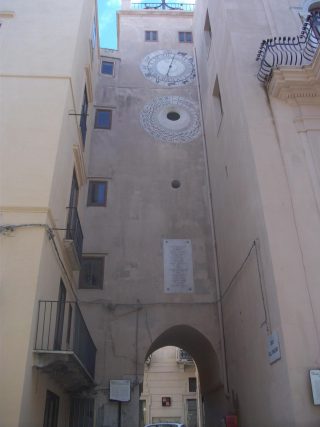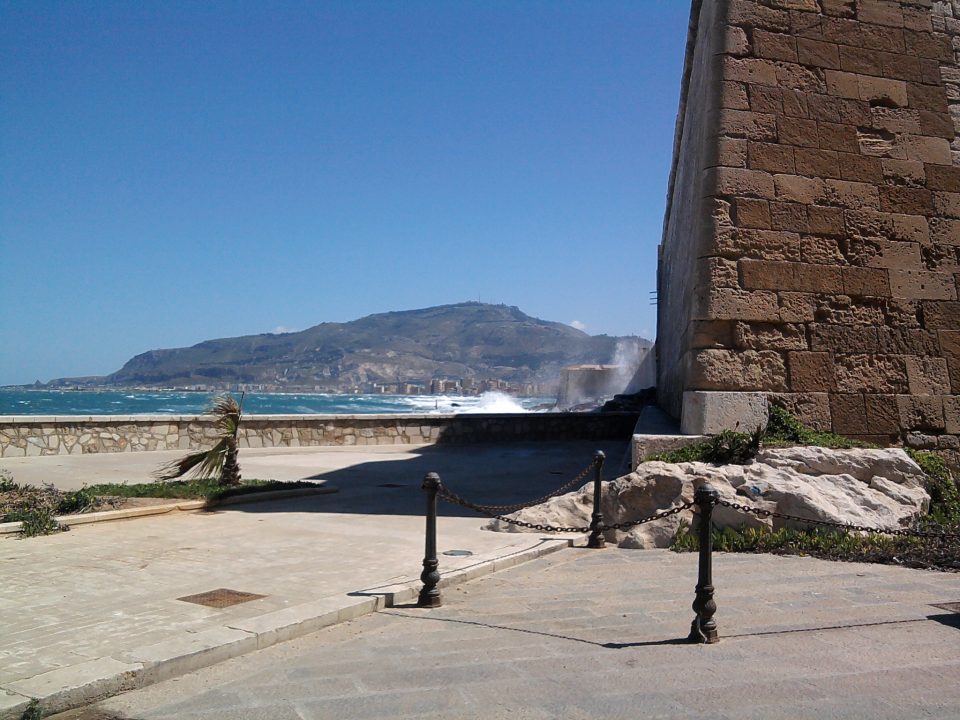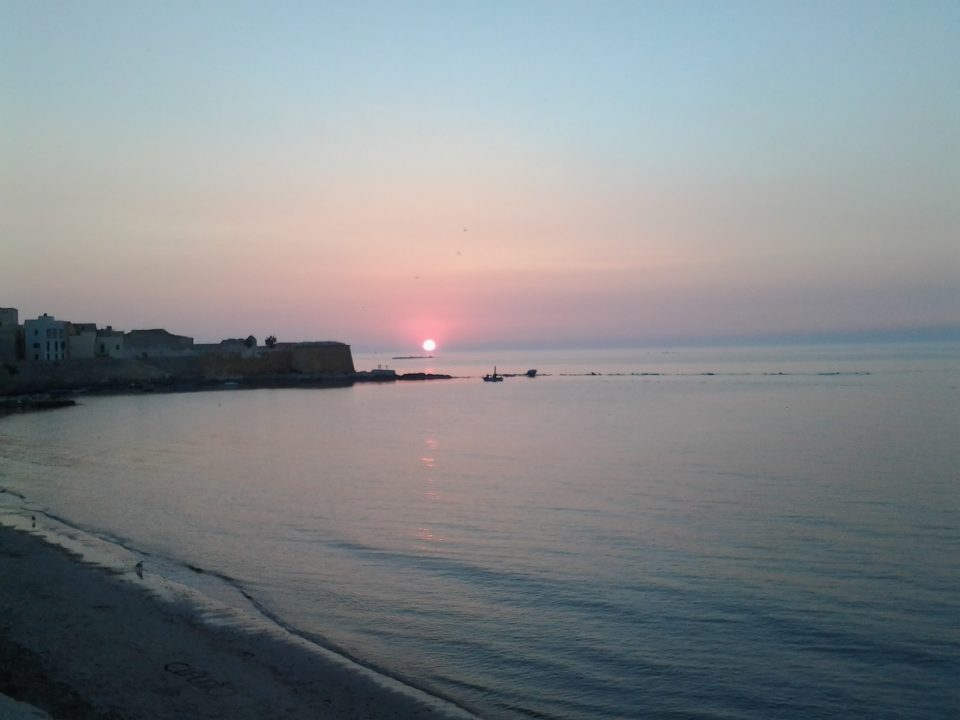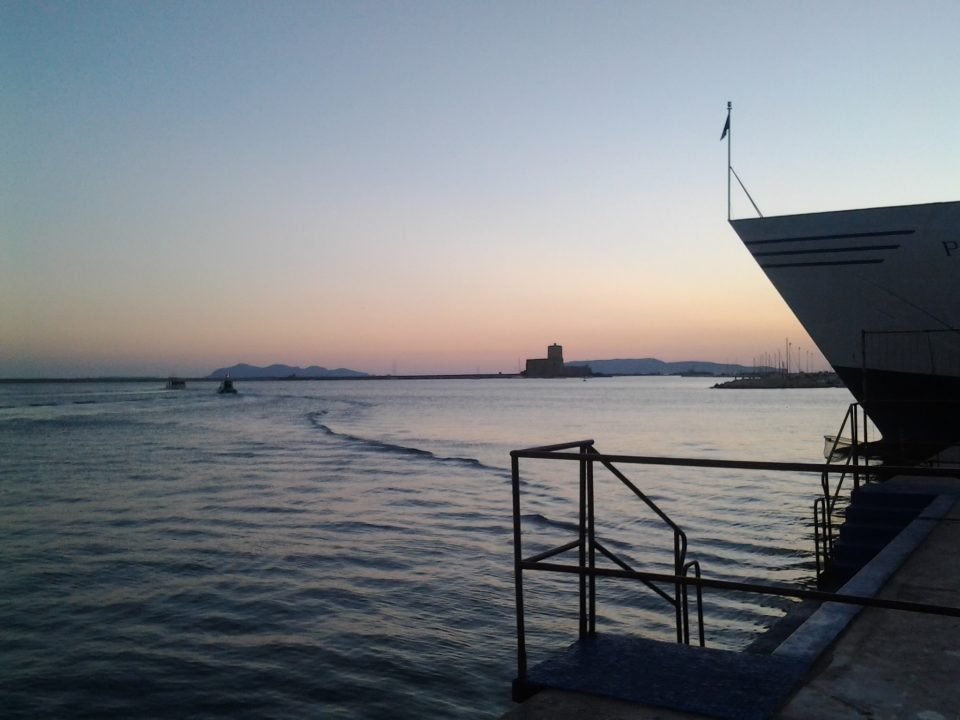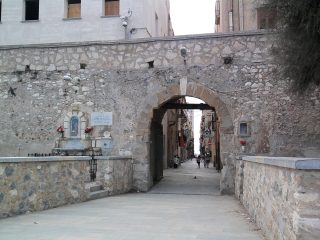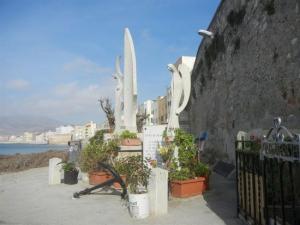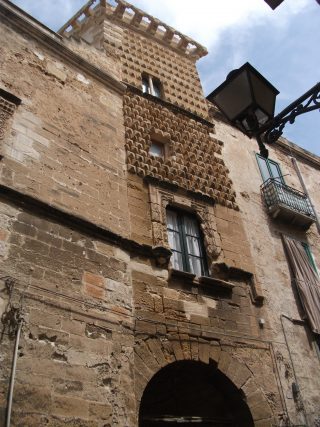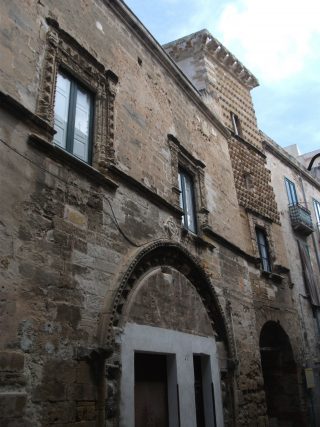Trapani coat of arms: towers, sickle and sea
Symbols in Trapani coat of arms are towers, arches, seakle and waves.
On Trapani coat of arms the oldest symbol is the sickle. From it comes the Greek name of the city: Drepanon. Under the sickle there is a porch that emerges from the sea. It consists of three arches of which the last one on the right is interrupted. Above the arches there are the Five Towers of which the second from the left is higher than the others. The symbolic meaning is evident: the city rises from the sea, lives thanks to the sea from which it always takes prosperity and wealth.
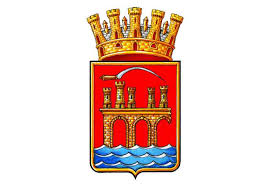 Arches represent the aqueduct, which since the 14th century had brought water from Erice inside the city walls (probably passing by present Via Archi). But it also may represent fortifications which made the area invulnerable.
Arches represent the aqueduct, which since the 14th century had brought water from Erice inside the city walls (probably passing by present Via Archi). But it also may represent fortifications which made the area invulnerable.
Towers symbolized security and protection for the city, and so we see them shown on the shield. Some towers are destroyed, while others still exist.
The towers of the very ancient town
Probably the presence of four sighting towers characterized the very ancient town.
They were Old Tower, Land Castle Tower, Pali Tower, Tower of the clock or Dark Door.
Peliade Tower (Sea Castle or Colombaia) was the fifth tower.
The four towers surrounded the town with quadrilateral boundary walls.
The current via Garibaldi, via XXX Gennaio, via Torre Pali and via Torre Arsa marked boundaries of the town.
Eastern walls ended with a moat, followed by a navigable canal. It separated the defensive walls of the historic centre from the suburbs and was near the present Via Spalti.
The canal also united the north sea with the south sea, that is the current beach side with the port side of the town.
Basically Trapani was a small peninsula reachable through a drawbridge.
The town had three main districts: the Casalicchio district, Palace district and Middle district, which were in turn divided into smaller districts.
Trapani during the Aragonese
During Aragonian rule, San Nicola district and Palazzo district added to the ancient San Pietro district.
They also built Rua grande (present Corso Vittorio Emanuele) and Rua Nuova (present via Garibaldi).
The construction of bigger boundary walls reinforced by bastions strenghtened defences.
Among these bastions Imperial Bastion or Saint Ann is still visible from “Viale delle Sirene”. It was first built in 1545, then Spanish completed it in 1673.
At the same north side Conca Bastion is at the end (or beginning?) of the ancient walls road (Mura di tramontana).
In the opposite side of the town, in XVI century they built Bastion of Impossible. It was part of the front line fortifications of the town together with Bastions at the Land Castle. Current Police Headquarters keeps the remains of the Land Castle.
At the beginning of the port area (Via Ammiraglio Staiti) there is Bastione dell’Impossibile, restored a few years ago.
Seems they have given the bastion the name “Impossible” because of problems during its construction due to muddy soil. Another hypothesis is because access to town was impossible for enemy.
Towers
1-Pali Tower. It no longer exists. It was located in the south-east, in San Pietro discrict. Its name comes from piles stuck in the ground next to it. Sailors used those piles to pull the boats off dry.
2-Old Tower. It was in the former Monastery of Badia Nuova. This monastery ended with an impressive tower at the beginning of the current via Delle Arti.
3-Dark Tower. It opens onto the current via Torrearsa. The quadrangular “tower of clock” sourmontes it. The tower displayes an astronomical clock with sun and moon dials, recently restored.
4- Land Castle Tower The original structure, of which only the northwest facade remains, consisted of a quadrilateral with rectangular towers and half circular towers on corners. The Land castle Tower located at Piazza Vittorio Veneto has Punic origin. It was restructured in the 14th century. After numerous changes in the 1800s the Land Castle assumed the appearance of a Bourbon barracks
The new construction of Police headquarters took its place.
From via Dante Alighieri we can see what remains of the land Castle and the tower.
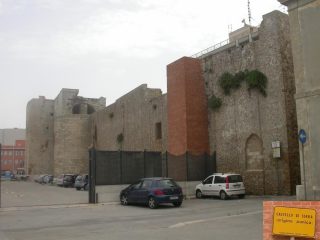
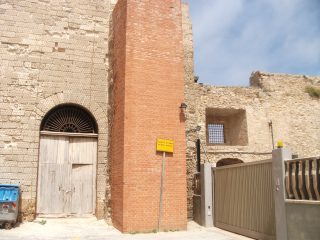
5- Peliade Tower, called Colombaia, is opposite to the Land Castle. During the Punic Wars, the Carthaginian General Amilcare Barca built the fifth tower, the Castle of Colombaia, in the small island near the port.
Trapani was a quadrangular city, so probably there was a tower at every corner, while the fifth could be the Colombaia. For this reason it is the highest tower on the coat of arms. Peliede Tower was outside the walls, so they depicted it higher to distinguish it from the other four towers belonging to the walls.
Doors in the walls
Furthermore, there were also many doors to enter the town, probably 11 or 12.
The only remained today are Porta Oscura and Porta Botteghelle, called Porta Ossuna. Of the other doors remains nothing but the memory of the names, such as Porta Serisso.
In Aragonan period they buit Porta Botteghelle, now called Porta Ossuna. From Corso Vittorio Emanuele it opens to the beach and a small port.
Close the door, a small square is dedicated to Virgin Mary with the marble group of Our Lady of the Abyss by Benini. It was finished in 2009 while the altar of Madonna of Trapani is by Leonardo Costantino (1983). Last year the marble sculpture depicting an angel has gone completely destroyed by vandals, crushed in so many pieces.
Our Lady of the Abyss is a sacred image representing the protector of those who have lost their lives at sea and those who work every day in the sea.
Porta Serisso was at the beginning of the homonymous street just opposite Porta Ossuna. Of it remains only an arch’s stringer.
Porta oscura and Torre dell’orologio are in via Torrearsa. Porta oscura is the oldest door in the town, probably it already existed at Carthaginian time. Over the centuries it has undergone several modifications. The tower holds a clock, probably built by Aragonese.
The modern city
While the old town dates back to Elimi, the modern city was born in the 19th century.
In 1862 Trapani lost its qualification of Piazza d’armi, so the government of the city knocked down most of bastions and walls. Finally, the town was able to expand to the east, towards the mount.
The canal was filled, Rua Grande and Rua Nova got the current names. They paved roads and build more streets, such as via Dante alighieri, Piazza Marina and Via Fardella. And so the Mail Post Office, Province Headquarters and Harbor Master Office dates back to this period.
After expropriation of ecclesiastical goods and the suppression of religious confraternities, many of their properties passed to the Municipality. The Second World War bombings destroyed San Pietro district. They rebuilt it with a new street, Corso Italia.
Palma and San Giuliano districts (which fall into the territory of Erice) and Cappuccinelli added to the traditional neighborhoods San Pietro, San Francesco, San Lorenzo, San Nicola, Sacro Cuore and Borgo Annunziata.
Giudecca Tower
Another tower, which is not in the coat of arm, is Giudecca Tower. It is in the old Jewish quarter, Via Giudecca, in front of the Court building. In the early decades of the XVIth century Ciambra family built it in the typical Spanish Plateresque style. In fact the tower is also called Palazzo Ciambra.
The tower hits for its ogival portal surmounted by the crest of the family and the side tower covered with indentations shaped as diamond tips. It has undergone many changes over the centuries. The main entrance is now walled up, as well as some windows. Sadly the whole building is not in good condition.
Close to via Giudecca there is the Catito district, once the most populated. Old Jewish-Arab neighborhood of medieval origin, it was heavily damaged by bombing and neglected for years. But now it has been restored.
source: Trapani e dintorni
Municipality tour guide
